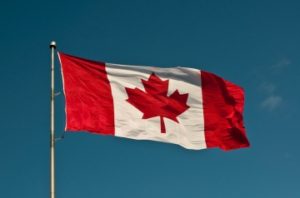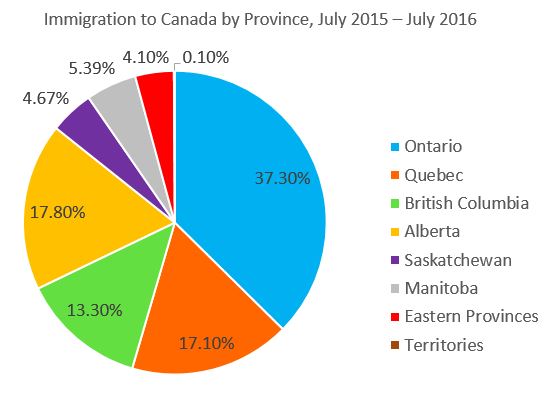Canada Welcomed a Record 320,932 New Immigrants Over the Past Year, With Immigration Numbers Set to Increase Even Further
 Increase in immigration numbers appears to be the largest in more than a century
Increase in immigration numbers appears to be the largest in more than a century
More than 320,000 new permanent residents settled in Canada in the past year, the highest total number for many decades. In the period from July, 2015 to July, 2016, a total of 320,932 new immigrants landed in the country as permanent residents. That is an increase of more than one third over the previous year, when 240,844 immigrants came to Canada, representing the fastest growth in nearly three decades. Moreover, the government of Canada is planning to welcome even more newcomers over the coming years.
Statistics Canada (Statscan) revealed these latest figures this week in its annual population count. Though earlier data are not strictly comparable, the latest Canadian immigration numbers appear to be the largest in more than a century at least 1971, when comparable records began, according to Statscan.
Under the current data-gathering methodology, the previous record for new immigrants was set in 2009-2010, when 270,581 people arrived in Canada.
Where are new immigrants going?
According to the Statscan report, the Prairie provinces (Alberta, Saskatchewan, Manitoba) are becoming more popular destinations than ever before. In the past year, 27.9 per cent of new immigrants settled in one of these provinces. Alberta, which received 57,384 people, ranked as the second most popular destination for newcomers of all the provinces. Manitoba (17,238) and Saskatchewan (15,006) also boosted their immigration numbers.
Ontario remained the most popular destination province, with 37.3 percent of all newcomers landing there. Meanwhile, Quebec welcomed 55,164 new immigrants, (17.1 percent of the total). More than half (54.4 percent) of all new immigrants to Canada landed in Ontario or Quebec.
Most provinces broke records
Not only did all provinces welcome more immigrants, six provinces actually took in record numbers of immigrants in 2015-16. In Eastern Canada, Newfoundland and Labrador (1,406), Nova Scotia (5,390), and New Brunswick (4,435) all took in record numbers, as did Manitoba, Saskatchewan, and Alberta.
British Columbia received 42,832 newcomers, while Prince Edward Island (2,008) and the Territories (Yukon, Northwest Territories, and Nunavut, 512 in total) also continued to welcome new immigrants.

Significant reduction in processing times
In the 12-month period under review, processing times for all permanent residence programs together decreased by a massive 42 percent. The shortest average processing times are for applications submitted under one of the federal economic programs managed through the Express Entry selection system: the Federal Skilled Worker Class, the Federal Skilled Trades Class, and the Canadian Experience Class. Complete applications submitted under one of these programs are typically processed to in 3-5 months. Express Entry allows the government to select which individuals are able to submit an application through a federal economic program. As a result, the government can manage supply, and therefore reduce processing times.
In addition, the government continued to work through a backlog of applications that were submitted before Express Entry came into operation. It was also revealed that processing times on these applications were reduced.
Other reductions occurred in Quebec Skilled Worker application processing times, which are down by 28 percent year-over-year for the federal stage, as well as Family Class applications, which have seen an overall reduction in processing times of 15 percent.
The programs that come under Canada’s Humanitarian immigration category saw a reduction in processing times of 38 percent. Canada’s refugee settlement programs come under this category.
Reasons for the increase in immigration numbers
- Express Entry and the backlog
Since Express Entry was first launched in January, 2015, the government has processed applications through the new system, in addition to working through a backlog of applications submitted before Express Entry came into operation. The period under review in the report runs from July, 2015 to July, 2016, and we know that far more newcomers who submitted applications through Express Entry landed in the second half of 2015 than the first half of 2015. Throughout 2016, the government has continued to issue Invitations to Apply (ITAs) to candidates in the pool.
- Provincial Nominee Programs
Over the past year or two, Canada’s Provincial Nominee Programs (PNPs) have become more dynamic, with an increasing number of applications being submitted under these programs. When the government revealed its 2016 Immigration Plan in March, it set a target of up to 48,000 for new arrivals through the PNPs this year alone. Provincial governments have also been active in lobbying the federal government for larger allocations for the PNPs; Nova Scotia and British Columbia, in particular, have been successful in this regard.
Most provinces and territories have at least one PNP dedicated to attracting Express Entry candidates for immigration to Canada, with more categories being introduced on an ongoing basis. Candidates who receive a provincial nomination certificate through one of these enhances PNP categories benefit from quick processing times.
- Syrian refugees
One of the first signature acts of Canada’s new Liberal government was the arrival of Syrian refugees, which began in November, 2015. This spike in refugee immigrants partly explains the overall increase. At last count, Canada had welcomed 30,862 refugees, with thousands more still to be processed.
- New government
The Liberal government of Canada, led by Prime Minister Justin Trudeau, has been vocal in its support of immigration and immigrants across all categories. The government has recognized that Canada faces demographic and labour challenges, and that immigration is an important part of solutions to these challenges. Moreover, the Liberal Party has traditionally embraced multiculturalism and is generally perceived as a pro-immigration party.
Government wants to “substantially increase” immigration
Over the summer months, Canada’s Minister of Immigration, John McCallum, stated his intention to “substantially increase” the number of new immigrants to Canada in order to fill labour shortages and confront the demographic challenges of an aging population.
Speaking in August, 2016, McCallum said, “Why not substantially increase the number of immigrants coming to Canada? The direction in which I would like to go is to increase substantially the number of immigrants.
“We’re going to reduce some of the barriers in our immigration system . . . we think it can be simplified. We think there are some rules which are no longer necessary,” added McCallum.
The Liberal government, which took office less than one year ago, plans on unveiling its overall immigration strategy in the near future, with a three-year plan expected to be released in November of this year.
An optimistic vision for Canada
“Though it is still relatively early days in the life of this government, its work on the immigration front has been positive. The government has approached immigration in a realistic way, while retaining an optimistic vision for the country,” says Attorney David Cohen.
“While other countries increasingly look inward from the world, Canada is actually going out there and laying out the welcome mat for an increasing number of newcomers from around the globe. This includes professionals, families, international graduates, relations of current Canadian permanent residents and citizens, and those fleeing hardship.
“We can expect future figures to show not only that Canada is increasing immigration numbers, but ultimately that newcomers are building successful lives in Canada for themselves and their families. Canada has a government that is prepared to invest in the country, its people, and its immigrants.”
To find out if you are eligible for immigration to Canada, please fill out a free online assessment today.
© 2016 CICnews All Rights Reserved
- Do you need Canadian immigration assistance? Contact the Contact Cohen Immigration Law firm by completing our form
- Send us your feedback or your non-legal assistance questions by emailing us at media@canadavisa.com






